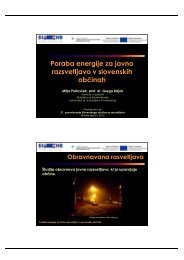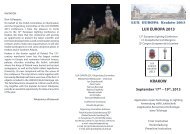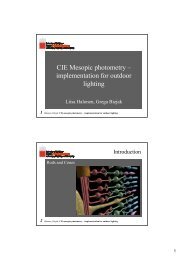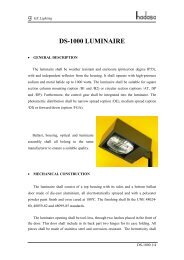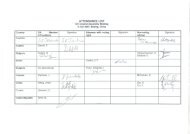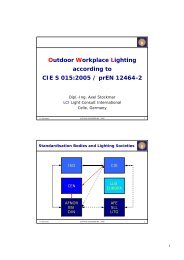Zbornik - SDR
Zbornik - SDR
Zbornik - SDR
Create successful ePaper yourself
Turn your PDF publications into a flip-book with our unique Google optimized e-Paper software.
“Lighting Control Systems To Improve energy performance…” R-5<br />
Determining real energy saving potentials of any lighting control device or system is not an exact<br />
science, since their performance depends on how they are applied and used. However more accurate<br />
information on actual potential energy savings and availability of easy and reliable evaluation<br />
methods could increase designers’ awareness and confidence in choosing lighting control systems for<br />
both new or renovated buildings.<br />
6 Conclusions<br />
Interest in control systems and natural and artificial light integration has recently increased, as<br />
has choice in products and solutions by lighting system manufacturers and companies from the<br />
automation sector.<br />
Nevertheless, frequently systems installed in tertiary buildings (office blocks, schools, etc.) have<br />
been deactivated or tampered with following users’ non acceptance and dissatisfaction with<br />
performance, but also by the impossibility or difficulty to interact with the system. This lack of<br />
success is due to an uninformed choice of system or to it being unsuitable for tasks carried out in the<br />
environment or user characteristics, incorrect design of system architecture, choice of components<br />
that don’t always communicate, or not last, the difficulty to programme each component or entire<br />
system. Customers and designers are often doubtful about these systems’ real efficiency when<br />
considering the frequently high installation costs.<br />
The Politecnico di Torino’s Department of Energy research in this sector is in fact inspired by<br />
these considerations. The last objective in this activity is to draw up guidelines for the light control<br />
systems project mostly for use by architects and lighting designers. The guide will cite results of both<br />
specific theoretic and trial studies currently underway as well as aiming at providing support for<br />
designers on:<br />
- state of the art of currently available control systems;<br />
- calculation methods for energy performance;<br />
- information on environmental and energy performance, degree of acceptance and ways of<br />
interaction between systems and user, in real situations.<br />
7 References<br />
1. CIE x015-1998, Proceedings of the First CIE Symposium on Lighting Quality, 9-10 May 1998,<br />
National Research Council Canada, Ottawa/Ontario, Canada<br />
2. Veitch J.A., 2001, Psychological processes influencing Lighting Quality, Journal of the<br />
Illuminating Engineering Society, Vol 30, n.1, pp124-140<br />
3. Boyce P.R., Human factors in lighting, 2nd Edition, Taylor & Francis, London, 2003<br />
4. REA, M. S., The IESNA Lighting Handbook. Reference & application, Ninth Edition, FIES<br />
editor in Chief , New York, 2000<br />
5. http://ec.europa.eu/energy/demand/legislation/buildings_en.html,<br />
6. CIBSE Briefing 6, The Energy Performance of Building Directive, Chartered Institution of<br />
Building Services Engineers, 2003, London (www.diag.org.uk/pdf/CIBSE_Briefing.pdf)<br />
“Lighting engineering 2006” stran 45



